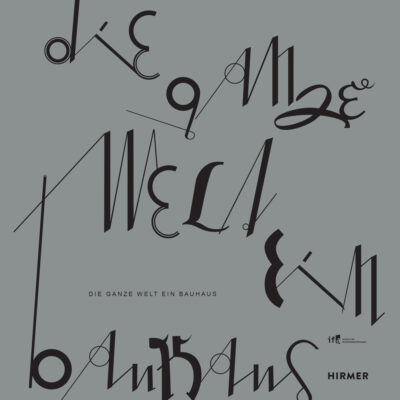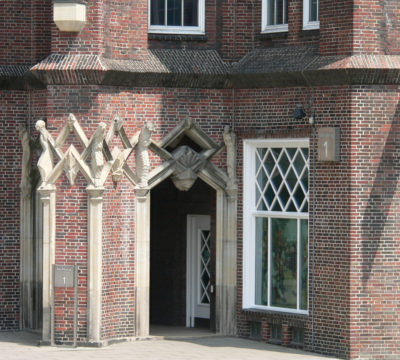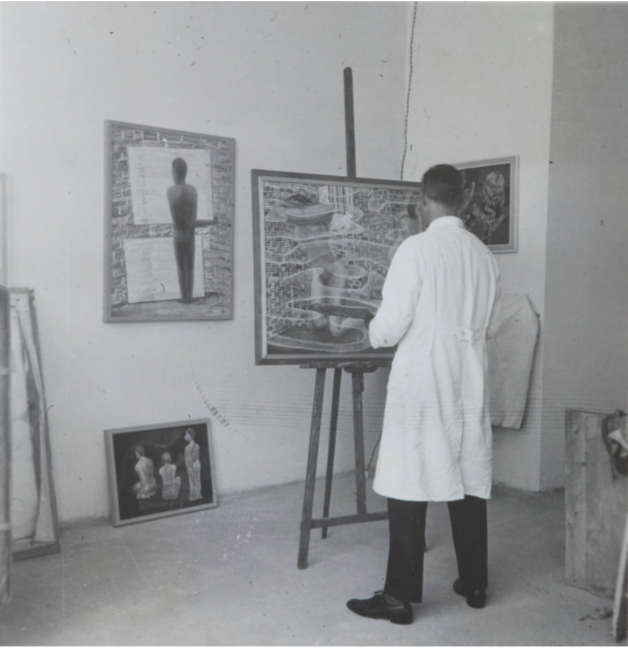
Ludwig Hirschfeld Mack
More Than A Bauhaus Artist
A new book telling the story of one of Modernist Germany’s most influential artists. A life bound up with Oskar Schlemmer, Hans Scharoun, Paul Klee, Kandinsky and other greats
Ludwig in his studio in Berlin with a painting of women surrounded by gas-like substances
Bauhaus artist, Ludwig Hirschfeld-Mack, a man whose name should really be more well known than it is. His journey took him from Weimar to Berlin, from Welsh mining communities to the most English of public schools, to being wrongly classified as an Enemy Alien. His final humiliation was being arrested, interned and sent to Australia on the infamous HMT Dunera – and while on board witnessing inhumane treatment by guards.
Now, with meticulous research by Resi Schwarzbauer and Chris Bell (Ludwig’s grandson), we have the opportunity to learn about how a German artist ended up as a much-loved secondary school teacher in Australia, turning down the opportunity to join his friends and colleagues, Walter Gropius and Josef and Annie Albers, in America. And how unexpectedly, it was in Australia that he found peace and fulfilment.

Abstract 1962 Watercolour and pencil over monotype on woven paper, 28.7 x 22cm Gift of Mrs L. Hirschfeld Mack 1976 Collection: Queensland Art Gallery | Gallery of Modern Art, Brisbane © Chris Bell
‘Hirschfeld-Mack is often described as a Bauhaus Artist, but really he was much more than that, explains Resi Schwarzbauer. ‘He was a musician, inventor, performer, pacifist, and deep thinker. For most of his life, Ludwig was a teacher and James Darling, a former Headmaster of Geelong Grammar School, commented that:
‘He inspired dozens of boys with his integrity and enthusiasm. He was an almost perfect man . . . a beautiful character and an original teacher’
Born in Frankfurt am Main Germany in 1893, Ludwig was the eldest son of Ernst and Clara (née Mack). His father was the wealthy owner of a leather factory that had a presence in England. The family frequently visited and even had English students staying with them in Germany; His childhood was idyllic with loving parents and four younger siblings. It was in 1911 in Frankfurt that 18-year-old Ludwig met Elenor Wirth, later to become his first wife.

Ludwig and his brother Gustav in uniform with their siblings
He began his art education in Munich in 1913 at William Debschütz School, the Instructional and Trial Workshops for Applied and Fine Art; he continued until the outbreak of war, a war he witnessed at close range that was to leave an indelible mark on his life. He returned as a fervent pacifist and remained true to that view throughout his life. In 1917 he married Elinor and like so many at the end of the war contracted influenza in the pandemic of 1918-19. By April 1919 the Bauhaus was founded.

Ludwig and his brother Gustav in uniform with siblings Emmy and Lotte
Art as a tool to improve the world was always at the centre of his thinking, Hirschfeld-Mack was immediately attracted to Walter Gropius’ 1919 Bauhaus Manifesto which set out a vision for a better world
“… which can embrace architecture and sculpture and painting in one unity….”,
Among the first students to enter the Weimar Bauhaus; in the 1922-23 term he conducted colour seminars for fellow students which were sometimes attended by Bauhaus teachers Wassily Kandinsky and Paul Klee.
One of Hirschfeld Mack’s first woodcuts produced at the Bauhaus was titled
“Völkerbund” – A League of Nations striving for world peace

“Völkerbund” – A League of Nations striving for world peace.
It is little wonder that his friend and Bauhaus founder Walter Gropius described him as
‘ein geborener Lehrer – a born teacher’
Farbenlichtspiele, colour light plays
It was here at the Bauhaus that his creativity and musical ability came to the fore and he developed his Farbenlichtspiele, colour light plays which consisted of shapes in various colours and hues, with the colours moving across a screen in harmony with (the) music. This led to his invention of a colour-light apparatus, used in many colour-light play performances in Germany and Austria and in his becoming one of the contributors to the Der Absolute Film, in Berlin, where he appeared alongside luminary early film producers such as Hans Richter, Viking Eggeling, Walter Ruttmann, Fernand Léger, Francis Picabia and Renée Clair.
With a combination of knowledge and artistry, he was able to adapt his invention so it could be used as an advertising apparatus and a kaleidoscope for theatrical productions. This black and white composition below depicts the different shades of colour.

Scene from Farbensonatine II Rot (colour sonata red) 1923/24 . 8.6 x 11.4 cm. Photographer unknown, Melbourne University Archives, item no. 1971.0009.0044.
Durckdrückzeichnung
Another invention was a groundbreaking new approach to printing which he called Durckdrückzeichnung – a monoprinting method, utilised by Paul Klee, he also developed the use of calsomine.
Below are examples of the Durchdrückzeihnung method and the Calcimine method invented in Australia.

1976.39 The musicians 1962 calcimine and watercolour on canvas 42.3h x 47.3w cm Geelong Art Gallery, accession no. 1976.39 Gift of Mrs Olive Hirschfeld, 1976 © Chris Bell

Abstract 1962
Watercolour and pencil over monotype
on wove paper, 28.7 x 22cm
Gift of Mrs L. Hirschfeld Mack 1976
Collection: Queensland Art Gallery | Gallery of Modern Art, Brisbane
© Chris Bell
Shortly after the closure of the Weimar Bauhaus in 1925, Ludwig began teaching young children at the revolutionary co-education school Freie Schulgemeinde in Wickersdorf.

Students from the Freie Schulgemeinde Wickersdorf with Ludwig Hirschfeld Mack
This was followed by a teaching contract at Otto Bartning‘s Bauhochschule in Weimar before he secured a professorship at the Teacher Training Colleges in Frankfurt an der Oder and Kiel. It was in Frankfurt an der Oder that he developed a friendship with the educational reformer and advisor to the Prussian Minister of Culture, Adolf Reichwein. Sadly, Reichwein was executed in 1944 due to his association with the Hitler resistance movement.
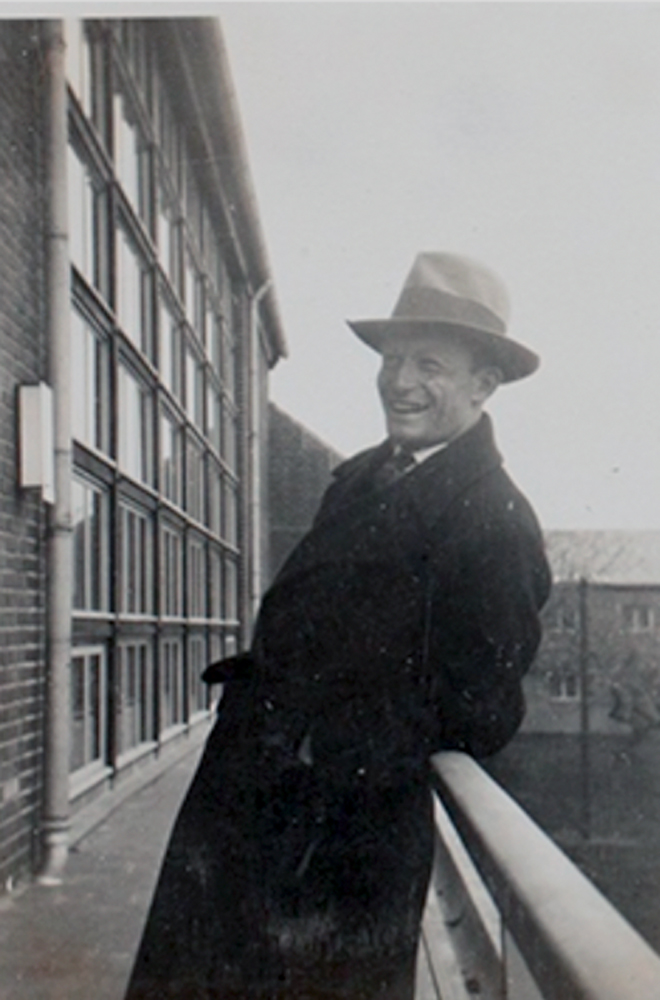
Adolf Reichwein at the Musikheim in Frankfurt/Oder
After the closure of these colleges by the Nazis, Ludwig moved to Berlin in March 1933 to seek employment. However, Nazi antisemitic legislation made his life extremely difficult, due to his Jewish heritage. He struggled to find a permanent position though he was able to earn some income by conducting private classes in instrument making. This brought him into contact with the composer, Carl Orff, and music educator, Fritz Jöde.
After spending three challenging years in Berlin, Ludwig finally had no option but to leave Germany for England in 1936, His long-term goal was now focused on moving to America to join friends and fellow Bauhausers Anni and Josef Albers and his sister-in-law, Irma, who were already there. His niece, Waltraut, shared that he was concerned that as a recipient of an Iron Cross in WW1 he might be called up to “fight for Hitler”, and this was the last thing he wanted to do.
It was increasingly clear to Ludwig that Hitler was a threat to peace and during his time in Berlin he produced a number of powerful images that reflected his thoughts at the time.
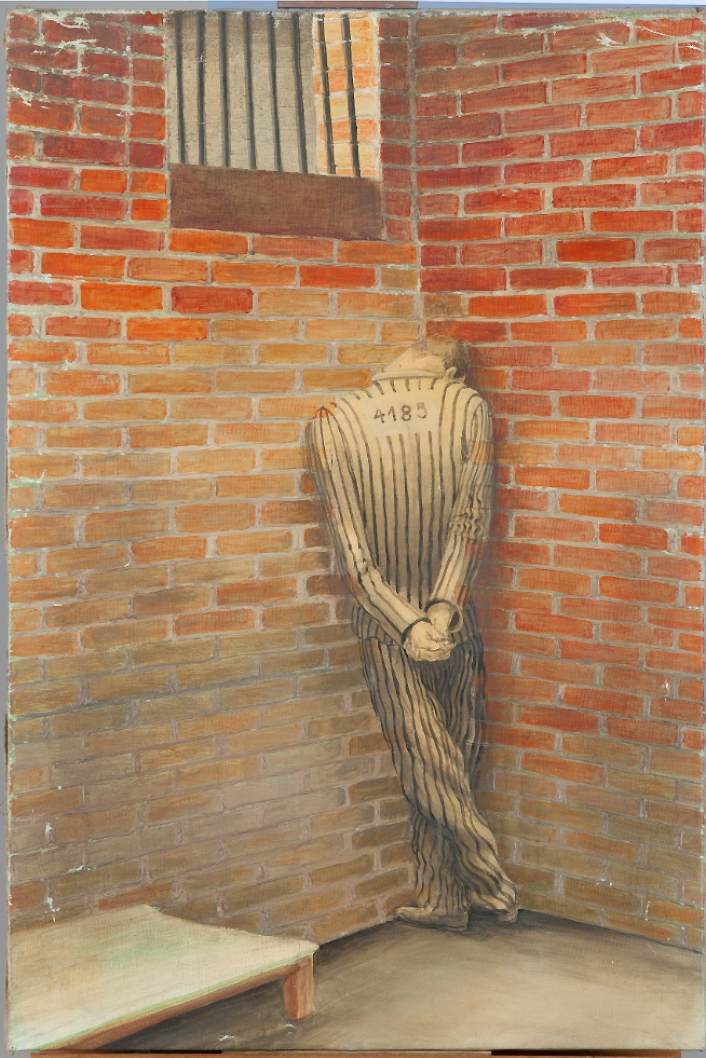
a man in a prison cell Oil on linen – 90 x 60 cm Private Collection © Kaj Delugan
The decision to leave his wife Elenor and their three children in Germany was not an easy one and was made even more difficult because his wife had developed multiple sclerosis; however, the move had her full support. Nevertheless, there would have been some comfort for her in that also living in Berlin Siemensstadt were their dear friends the Schlemmers, as well as Hans Scharoun, one of the architects involved in the Siemensstadt project, and his wife Anna. Ultimately, two of Ludwig’s daughters followed him to England, one stayed on while the other returned to Germany, tragically committing suicide a few years later.
While it is uncertain how a friendship developed between the Hirschfelds and the Scharouns, it seems very likely that the connection was made through their close friends Oskar and Tut Schlemmer. Hans Scharoun and Oskar Schlemmer had both been at the same academy in Breslau (now Wroclaw in Poland). When Elenor had to leave Berlin to receive full-time care, Anna Scharoun was instrumental in finding Ludwig’s school-age daughter, Ello, accommodation and it was the Schminke family who agreed that she could stay with them in the home they had commissioned Hans Scharoun to build for them.

Haus Schminke©
After his arrival in England and while waiting for employment opportunities in the U.S, Ludwig accepted a position with the Quaker Subsistence Programme in Wales which involved teaching unemployed miners new skills. He was put in charge of the woodwork classes, and supervised the construction of an open-air theatre. When this programme was abandoned he returned to London towards the end of 1937 where he was offered employment at the Peckham Health Centre teaching children craft activities and instrument making. It was at this time that he invented his colour chord instrument that enabled children with no other knowledge of music to easily play; the method associated musical chords with a colour indicator – best described in the newspaper article below. In 1939 he was offered a position with Dulwich Preparatory College in London, his time at the highly regarded public school took a dramatic turn when, at the school’s evacuation camp in Cranbrook in Kent, he was detained as an Enemy Alien.

An article in the News Chronicle after Queen Mary visited the Peckham Health Centre and played the instrument. In England Ludwig chose to use his mother´s maiden name Mack, a German family name which the English associated with the Scottish Mac.
It could have all turned out quite differently; Walter Gropius wanted Hirschfeld Mack to join him in America, they had both fled to England – Gropius moving on to Harvard in ’37. Josef and Anni Albers were by now at the Black Mountain College in North Carolina, where ironically, Ludwig had been offered a position just before his arrest and detention in 1940.
Sent to Huyton Internment Camp near Liverpool, regardless that he was entirely innocent saw him living in packed conditions with, according to other internees’ recollections, only enough coal for a hot bath every two months and no furniture. He was then moved to Douglas on the Isle of Man, which eventually led to his deportation to Australia on the notorious HMT Dunera. After his internment at Hay, Orange and Tatura, he finally found refuge in 1942 as the Art Master at Geelong Grammar School, in the State of Victoria, at the invitation of its visionary Head Master Sir James Darling. Hirschfeld-Mack remained at the school for fifteen years in spite of receiving an invitation to join the staff of the New Bauhaus in Chicago.
After leaving Germany, Ludwig was always mindful of the need to reunite his family after the war and his original plan was for them to move to the United States, where his wife´s sister Irma had settled. Deportation to Australia changed the location of the reunion to Australia. Sadly Elenor was too sick to undertake the journey and passed away in 1953, however his youngest daughter, Ello, did visit him but then chose to return to Germany. In contrast, his oldest daughter, Marga, who had joined him in England before the war, went on to marry an Englishman, Kenneth Bell who, after the war, he managed to arrange the emigration of the Bell family to Australia. Later, he married Olive Russell, a Quaker, whom he had met during his internment at Tatura.

Four boys from Geelong Grammar working on straw construction (material studies) with Hirschfeld
University of Melbourne Archives 1971.0009.0057 © Chris Bell
In Australia, he left an indelible mark on the lives of a number of his students, many of whom have very fond memories of the time they spent with him. One student, Daniel Thomas, later became an art historian and curator while other students went on to become architects and art teachers. Furthermore, at Geelong Grammar School, Ludwig and his students left fond reminders of his time at the school, including among others the Art Room frieze and the Art School Gates.
I think it is my destiny within my limits, to give and expect nothing in return
Ludwig Hirschfeld Mack June 1963

Ludwig´s contribution to the school culminated in the naming of the new art building in 2003 the Hirschfeld Mack Centre. The Hirschfeld Mack Centre opened in 2003 – Photographer Matilda von Bibra
The biography, Ludwig Hirschfeld-Mack, more than a Bauhaus Artist, has been described as the culmination of two decades of research drawing on extensive family archives and oral histories and relying heavily on material in Australia, Germany and the United States. It also draws on the memories of former students and friends. More than that it’s a terrific read and important addition to the history of the Bauhaus School. It makes clear the effects the two World Wars had on Ludwig’s life, as well as on the lives of his family and friends.
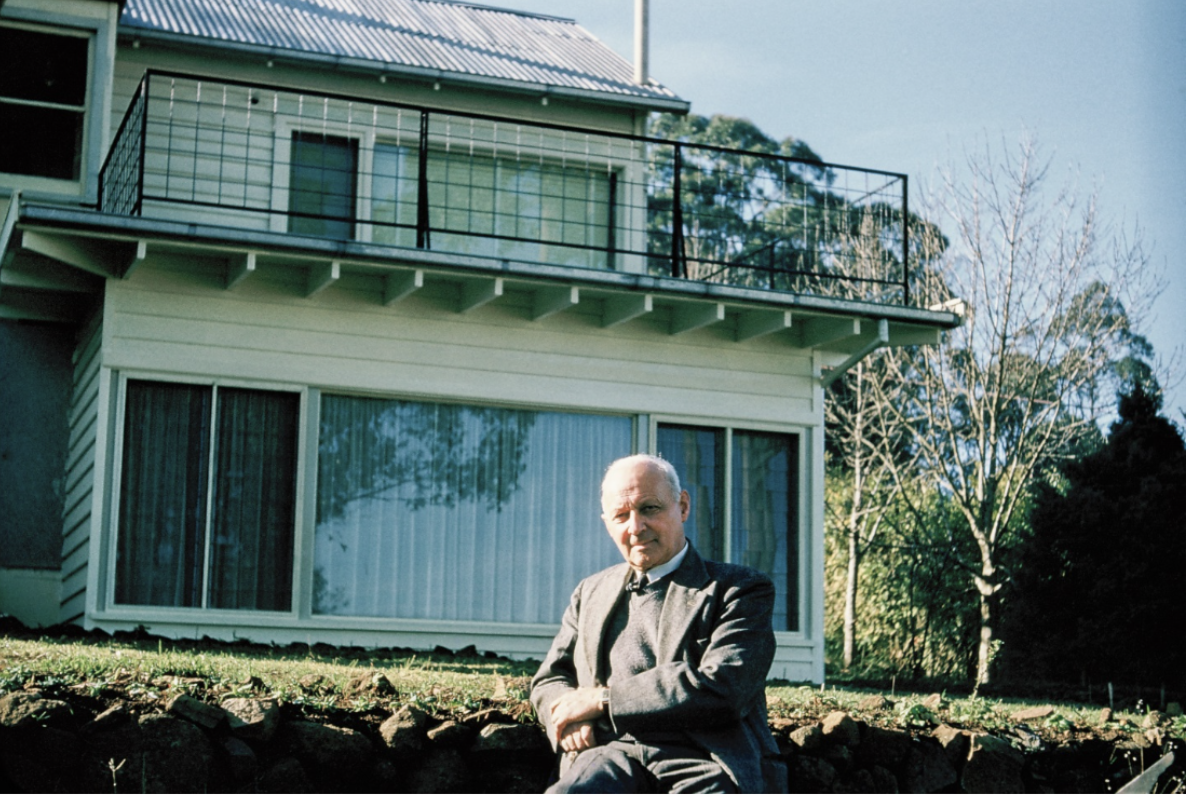
Ludwig in front of his studio at Redro in Ferny Creek. Photographer unknown
© Images from the private collection of the descendants of the Hirschfeld family, unless otherwise stated are the Copyright of the grandsons of LHM – Chris Bell, Australia and Kaj Delugan, Austria
Images cannot be reproduced without the permission of the family, author or relevant archives






